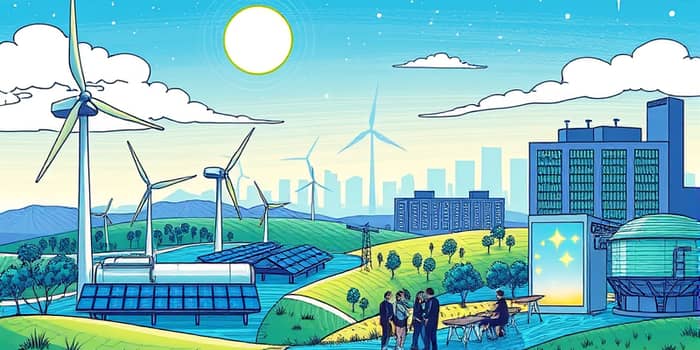The global shift from fossil fuels to cleaner energy sources is reshaping industries, policies, and investment strategies. As governments and corporations commit to net-zero goals, the energy transition emerges not only as an environmental imperative but also as a vast arena of economic growth. By understanding the evolving market dynamics, companies and investors can position themselves at the forefront of innovation.
Global Investment Landscape and Market Scale
In 2024, record $2.1 trillion in 2024 propelled the energy transition, marking an unprecedented annual rise of 11%. Renewables led the charge, with new renewable energy projects attracted $386 billion in the first half of 2025 alone, a 10% uplift year-over-year. Despite these gains, utility-scale solar and onshore wind asset finance dipped 13%, underlining the complexity of capital flows.
The renewable sector’s projected trajectory remains bullish. By 2050, wind and solar are forecasted to compose over half of global electricity generation, though realizing that vision depends on continued policy support and technological advances.
Sector-by-Sector Momentum and Innovations
The renewable power mix is expanding rapidly. Wind and solar will dominate power mix across all decarbonization pathways, while battery storage capacity nearly doubled in 2024 to 29 GW in the US, with 47% growth expected in 2025. These storage solutions are critical to smoothing out the variability of wind and solar generation.
Meanwhile, nuclear energy is experiencing a renaissance. Traditional large reactors are complemented by small modular reactors (SMRs), especially in China, which is set to surpass Western nuclear capacity by 2030. In parallel, natural gas—once lauded as a transitional fuel—is finding a long-term role through carbon capture enhancements.
Onshore wind, however, is confronting headwinds from supply chain snags, siting conflicts, and financing hurdles. The US installed only 5.3 GW in 2024, reflecting a plateau in growth despite a total capacity of 153 GW. The solar sector, too, is adjusting to policy shifts and interconnection delays, with installations dipping before stabilizing after 2030.
Regional Dynamics and Strategic Advantages
Opportunities vary significantly by geography, shaped by policy, resource endowment, and market maturity. Key regional trends include:
- Europe: Prioritizing energy security and renewables, with declining LNG imports and ambitious climate targets.
- Asia-Pacific: Leading in LNG demand, nuclear build-out, and massive solar and wind deployments.
- United States: Experiencing policy-driven investment swings, but supported by infrastructure bills and reshoring incentives.
- Emerging Markets: High demand growth but constrained by financing gaps and grid reliability challenges.
Driving Forces Behind Growth
Several converging factors power the energy transition’s momentum. Corporate commitments to 100% renewable power have ignited a surge in clean energy procurement, while electrification of transport and buildings amplifies electricity demand. The rise of AI and data centers adds further pressure, with over 140 GW of new data center proposals in the US for 2025 alone. Together, these dynamics underscore data center expansion driving unprecedented energy demand worldwide.
Barriers, Risks, and Mitigation Strategies
Despite the optimism, the path is strewn with obstacles. Supply chain constraints, interconnection delays, and permitting bottlenecks threaten timelines for wind and solar projects. Policy uncertainties—such as shifting tariffs or tax credit eligibility—can stall financing, as seen in the US and parts of Europe.
Market risks also emerge from power price volatility; in saturated grids, negative pricing and curtailment have squeezed renewables’ returns. Labor shortages, particularly within the US solar installation workforce, further compound challenges. Strategic mitigation requires diversified supply chains, streamlined permitting processes, and investment in workforce training.
Case Studies Illuminating Success
Across the globe, pioneering projects demonstrate the transition’s potential. In New York State, community solar programs have mobilized local capital and engaged underserved consumers. In Asia, multi-billion-dollar LNG terminals backed by long-term contracts underscore gas’s evolving role in a low-carbon future. Meanwhile, a hyperscale data center campus in Texas integrates on-site renewables and battery storage, showcasing how demand centers can become energy innovation hubs.
Looking Ahead: Future Outlook and Key Inflection Points
The coming years will reveal which technologies and strategies prevail. Green hydrogen tied to industrial decarbonization efforts is attracting billions in venture and infrastructure capital, while circular economy solutions in materials processing offer new revenue streams. Carbon capture, utilization, and storage (CCUS) will be essential for hard-to-abate sectors, provided supportive policy frameworks materialize.
Grid flexibility and backup solutions—demand response, peaker plants, and distributed storage—are emerging as lucrative niches. Investors will gravitate toward markets where policy stability, grid integration, and local supply chains converge. Ultimately, success in the energy transition will require not only capital but also collaboration across governments, communities, and industries.
As we navigate this trillion-dollar transformation, stakeholders have a unique chance to align profitability with planetary health. By identifying and engaging with high-impact opportunities today, businesses can help chart a sustainable course for tomorrow’s energy landscape.
References
- https://www.rff.org/publications/reports/global-energy-outlook-2025/
- https://about.bnef.com/insights/clean-energy/global-renewable-energy-investment-reaches-new-record-as-investors-reassess-risks/
- https://www.weforum.org/publications/fostering-effective-energy-transition-2025/in-full/redefining-global-energy-systems/
- https://seia.org/research-resources/solar-market-insight-report-q2-2025/
- https://www.wri.org/insights/accelerating-the-energy-transition-6-opportunities
- https://www.wri.org/insights/clean-energy-progress-united-states
- https://about.bnef.com/energy-transition-investment/
- https://www.statista.com/statistics/639788/renewable-energy-market-size-worldwide-projection/










